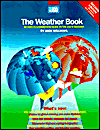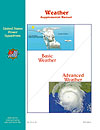Please note: A new version of the Weather Course is available. Information taught will be essentially the same a presented here, but with a new text and class format. A course is planned for Fall 2009.
| Wx 101 - Basic Weather - topics include: | Wx 102 - Advanced Weather - topics include: |
|
|

|
The USA TODAY Weather Book by Jack Williams explains the basics of meteorology with text and the kind of colorful graphics that have become USA TODAY's trademark. The American Meteorological Society (AMS) awarded Williams its Louis J. Battan Author's Award for the book in January 1994. The AMS and many scientists have commented on the book's scientific accuracy and the AMS is using it in its education program. |
 |
The USPS provides a supplemental text, containing additional information, homework questions, and references. |
| A set of synoptic weather charts will be used for an exercise in forecasting. (If you don't know what "synoptic" means, you will after the class.) |
| A PowerPoint or jpeg slide set of cloud formations is available for downloading from the USPS Marine Environment Committee website. Click here or go to http://www.usps.org/national/eddept/wx/main.htm#downloads. |
| For the instructor, PowerPoint slides are available on a CD-ROM and the USPS Supplement has additional information. |
Note: This schedule is for a course taught in 2005. A course is planned for late 2008 or early 2009, whenever the next version is available.
| Week | Date | Subject |
| 1 | Jun 7 | Intro and Guest Speaker |
| 2 | Jun 14 | Effects of Heat and Cold |
| 3 | Jun 21 | Wind and Pressure |
| 4 | Jun 28 | Storms and Fronts |
| 5 | Jul 5 | Break |
| 6 | Jul 12 | Rain, Humidity, and Fog |
| 7 | Jul 19 | Floods, Droughts, and Winter Precipitation |
| 8 | Jul 26 | Review |
| 9 | Aug 2 | Exam |
| 10 | Aug 9 | Thunderstorms and Tornadoes |
| 11 | Aug 16 | Field trip to NWS (map to NWS) |
| 12 | Aug 23 | Tropical Weather |
| 13 | Aug 30 | Atmosphere and Clouds |
| 14 | Sep 6 | Forecasting |
| 15 | Sep 13 | Climate |
| 16 | Sep 20 | Exam |